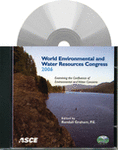Applying a Vadose Zone Model to Stormwater Infiltration
Publication: World Environmental and Water Resource Congress 2006: Examining the Confluence of Environmental and Water Concerns
Abstract
Urbanization has been responsible for an increase in the amount of impervious surfaces, leading to an increase in stormwater runoff and a decrease in groundwater recharge. Stormwater runoff contains pollutants, such as nutrients, pathogens, heavy metals, solids, organic compounds, pesticides, and chlorides, which have greatly contributed to the degradation of receiving waters due to surface discharge of stormwater. This has prompted stormwater managers to consider implementing more infiltration practices into their designs. However, past studies have shown that infiltrating stormwater could contaminate the groundwater, and in some cases contamination actually has occurred. Therefore, methods for easily predicting contamination potential need to be developed. Stormwater pollutants interact with the soils in the unsaturated zone as they migrate towards the groundwater. The specific type of soil and its properties have a profound effect on the movement of water and pollutants. Zinc and sodium chloride were chosen to be the pollutants of interest because of their prevalence in stormwater, solubility, and differing migration rates. Through the use of the SESOIL model, factors such as pollutant concentration, rainfall, vadose zone thickness, intrinsic permeability, organic content, and soil pH were evaluated to determine which ones have the greatest influence on pollutant migration. A factorial analysis (26 full factorial) was used to evaluate the effects of these factors on the maximum penetration depth of zinc and sodium chloride. High and low values for the factors were selected from the literature and the NRCS soils database. The pollutants were treated as separate ions (Zn+2, Na+, Cl–), and the length of each simulation was set at 1 year. Results indicated that rainfall was a common factor controlling Zn+2, Na+, and Cl– migration. Concentration was also influential in Zn+2 migration, while intrinsic permeability affected Na+ and Cl–.
Get full access to this chapter
View all available purchase options and get full access to this chapter.
Information & Authors
Information
Published In
Copyright
© 2006 American Society of Civil Engineers.
History
Published online: Apr 26, 2012
ASCE Technical Topics:
- Chemical compounds
- Chemical elements
- Chemicals
- Chemistry
- Chloride
- Environmental engineering
- Groundwater
- Groundwater pollution
- Heavy metals
- Hydrologic engineering
- Hydrology
- Infiltration
- Pollutants
- Pollution
- Salts
- Soil pollution
- Stormwater management
- Vadose zone
- Water (by type)
- Water and water resources
- Water management
- Water pollution
- Water treatment
- Zinc
Authors
Metrics & Citations
Metrics
Citations
Download citation
If you have the appropriate software installed, you can download article citation data to the citation manager of your choice. Simply select your manager software from the list below and click Download.
